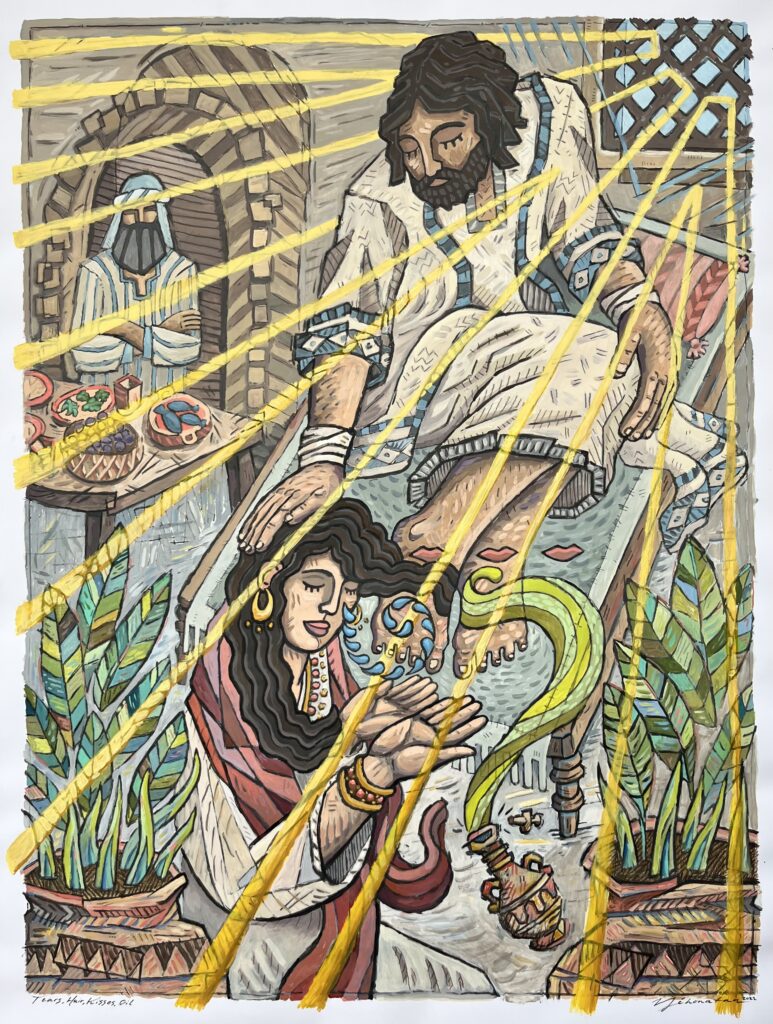“Art moves through us. It is colored by our individuality, but we are not precisely its origin. Or, to put it differently, a piece of art may originate with us, but we originate somewhere larger ourselves. We are, each of us, more than we seem, more than the sum of our merely human components. There is a divine spark animating each of us, and that divine spark also animates our art. When we dedicate a piece of art to something larger than our ego, that something larger becomes a felt presence. There is a breath of the divine that blows through us as artists and blows through our art as well.”
This is a quote from Julia Cameron’s book, The Artist’s Way Every Day: A Year of Creative Living. Jonathan Shaw reads from it every day and finds it very encouraging and motivating. The book was given to him in 2011 by his father, who is also an artist.
When Jonathan was young, he was deeply inspired by his father who traveled extensively to make films in different countries like Peru, Greece, India, and New Zealand. His father specialized in documentary filmmaking, exploring various cultures and religions, and sometimes worked on adventure and ski films. Jonathan remembers growing up and his father always bringing items home from different countries. When his father returned from India, he brought back with him Indian textiles, rugs, tapestries, and wooden carvings that Jonathan found fascinating. The intricate patterns and aromas in these objects left a lasting impression on him and greatly influenced his artistic style. Jonathan has a fondness for creating whimsical, folklore-inspired art that celebrates the beauty of nature, inspired by his childhood experiences with his father.
Jonathan grew up in a Christian home and always had an interest in Jesus. “I didn’t grow up in a home where superheroes were a big thing. I was more fascinated hearing about Jesus’ miracles. He was, in a sense, my superhero when I was young,” he explains. But he hastens to add, “I still like Star Wars, though.”
Jonathan’s artistic journey began in grade school, where he gained momentum and inspiration with the help of great art teachers during elementary, middle, and high school who encouraged him to keep pursuing his passion. In high school, he considered various career options including art therapy and art education, but his heart yearned to become a full-time professional artist.
For college, Jonathan contemplated attending Milwaukee Institute of Art and Design, but he chose the liberal arts route to be around a diverse group of people. He attended several schools, including Judson University, University of Wisconsin, and a community college near Aspen, before finishing his degree at Seattle Pacific University, where he was exposed to a vibrant art and music scene.
After college, Jonathan returned to his family farm in Wisconsin to create folk art. Those post-college years were filled with an assortment of odd jobs, ranging from an arts and crafts camp director, camp counselor, handyman, custodian for Elmbrook Church, and teacher. He even spent three-and-a-half years as a mailman, but a divine spark began to stir deep within his soul. He realized that he did not want to spend another decade doing the same things. Instead, he longed to pursue his dreams.
The dream was not simply about showcasing his works in galleries, but about manifesting his ideas and turning them into reality. As he explains, he longed “to live the artistic lifestyle—to create artwork, share it and sell it.” Although he had nurtured this dream since his teenage years, he’d begun to lose interest in it.

“Tears, Hair, Kisses, Oil’” by Jonathan Shaw
It was while working as a mailman that Jonathan felt a divine spark reigniting his artistic flame. For a year, he cultivated this desire by seeking the mentorship of two artists online and creating art after work.
The image of Peter walking on water haunted him, and he knew that if he took the step to pursue his art, the Lord would keep him afloat. He believed that the God of miracles could provide for an artist. And so, he stepped out of the boat, into the unknown waters of his artistic journey.
For two years, he has been walking on water with God, pursuing his dream of being an artist. This journey serves as a testament to the power of faith, perseverance, and following the call of the heart. Jonathan points to some early influence from other Christian artists. An early encounter with conceptual-based work came in high school, when he received a book, FAITH + VISION: Twenty-Five Years of Christians In Visual Arts, produced by CIVA that really inspired him to interact and think about such works.
Another life-changing interaction with a Christian artist came in 2009, when Jonathan encountered the writings of the artist Makoto Fujimura. Jonathan read where Fujimura was talking about the sinful woman in Luke 7:36-50, who comes to Jesus when he’s meeting with Simon the Pharisee. The woman weeps at Jesus’ feet and she brings down her hair, dries His feet, kisses His feet, and then pours out the alabaster jar of oil/perfume.
Jonathan recalls, “Makoto merged that story with artists, that artists can be seen as frivolous and as a waste. Why are you spending so much time and resources to create artwork, create all these things? And it’s like, to Jesus, that outpouring is beautiful, that offering is beautiful.” Jonathan later created a painting reflecting on the same theme.
Reflecting on his process, Jonathan explains that he starts his work in the sketchbook, where he finds intimacy in the smaller scale. From there, he blows up his work onto canvas. When working on his scriptural pieces, he reads Scripture and often doodles in the margins of his Bible. He begins with small paper and then revisits notes and sketches, sometimes over a period of years, until a piece is fully realized. His process is meditative and thorough, similar to the natural world, laying down seed and seeing what takes root. “There’s a germination that happens underneath the surface that you can’t really see,” he says. “Then there will come a season where it emerges from the ground. That’s how it goes for my biblical work.” He wants to expand beyond his biblical work and connect with artists outside of the church, so he is considering portraits and naturalistic landscapes to have a place in the secular art realm. By creating work that is not as explicitly Christian, he hopes to convey gospel messages through the vehicle of naturalistic art.
“Throughout my life, I have processed my experiences through the art of drawing and painting,” Jonathan explains. “It wasn’t until I was around four or five years old that I began to speak, and my delayed verbal communication may have contributed to my enhanced visual communication skills. To me, creating art through drawing and painting has always been a place to contemplate: an ideal way to reflect on life, explore my faith, and reminisce on memories.” ■
Jonathan is currently the artist-in-residence at Oholiabʼs Visual Art Gallery (see p. 7). You can find his artwork online at yehonatan-art.com.
Recommended Posts

Summer Mixtapes
June 7, 2024

Pastors: They’re Just Like Us!
June 7, 2024

What’s in Your Bible?
June 7, 2024


